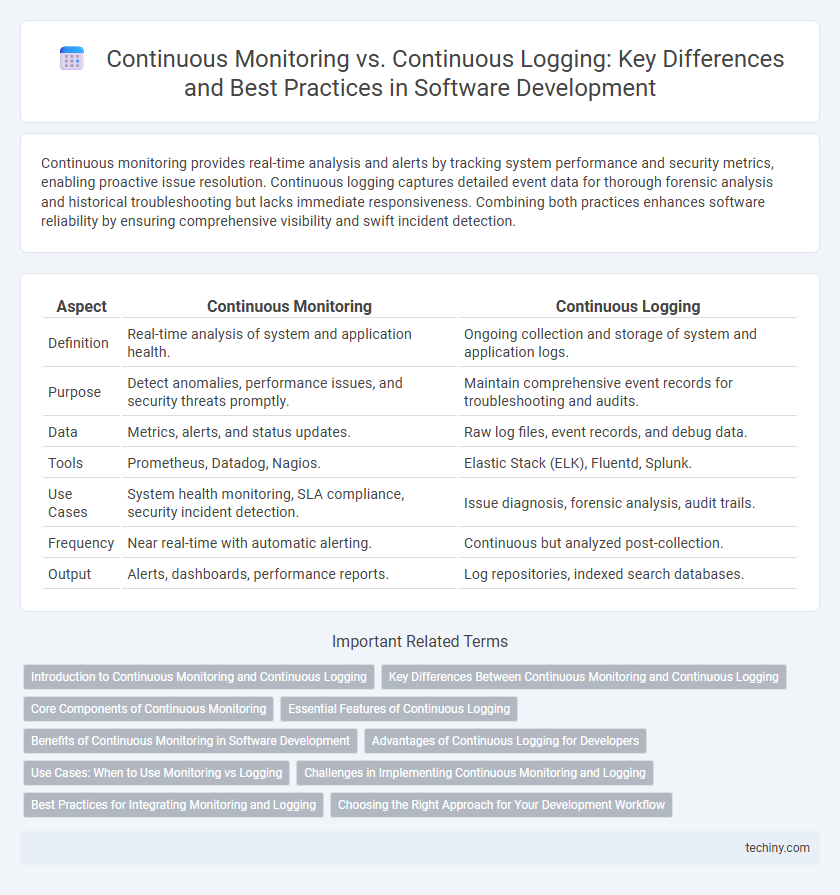Continuous monitoring provides real-time analysis and alerts by tracking system performance and security metrics, enabling proactive issue resolution. Continuous logging captures detailed event data for thorough forensic analysis and historical troubleshooting but lacks immediate responsiveness. Combining both practices enhances software reliability by ensuring comprehensive visibility and swift incident detection.
Table of Comparison
| Aspect | Continuous Monitoring | Continuous Logging |
|---|---|---|
| Definition | Real-time analysis of system and application health. | Ongoing collection and storage of system and application logs. |
| Purpose | Detect anomalies, performance issues, and security threats promptly. | Maintain comprehensive event records for troubleshooting and audits. |
| Data | Metrics, alerts, and status updates. | Raw log files, event records, and debug data. |
| Tools | Prometheus, Datadog, Nagios. | Elastic Stack (ELK), Fluentd, Splunk. |
| Use Cases | System health monitoring, SLA compliance, security incident detection. | Issue diagnosis, forensic analysis, audit trails. |
| Frequency | Near real-time with automatic alerting. | Continuous but analyzed post-collection. |
| Output | Alerts, dashboards, performance reports. | Log repositories, indexed search databases. |
Introduction to Continuous Monitoring and Continuous Logging
Continuous Monitoring involves real-time tracking of software systems to detect performance issues, security threats, and operational anomalies, enabling proactive incident management. Continuous Logging systematically collects, stores, and analyzes log data generated by applications and infrastructure for troubleshooting, audit trails, and compliance. Both practices enhance observability but differ in scope, with monitoring emphasizing ongoing system health assessment and logging focusing on detailed event recording.
Key Differences Between Continuous Monitoring and Continuous Logging
Continuous Monitoring involves real-time analysis of system performance and security metrics to detect anomalies and potential threats, whereas Continuous Logging focuses on the systematic collection and storage of detailed event data for later analysis. Monitoring tools provide proactive alerts and dashboards for immediate response, while logging solutions emphasize comprehensive data retention and forensic investigation. The key difference lies in Continuous Monitoring's emphasis on live system health assessment versus Continuous Logging's archival function for debugging and compliance.
Core Components of Continuous Monitoring
Continuous Monitoring in software development relies on core components such as real-time data collection, automated alerting systems, and performance analytics to provide ongoing oversight of application health and security. This process integrates continuous data ingestion from multiple sources, including logs, metrics, and events, enabling proactive identification of anomalies or security threats. Efficient Continuous Monitoring frameworks prioritize scalability, correlation engines, and dashboards to drive rapid incident response and maintain system reliability.
Essential Features of Continuous Logging
Continuous logging captures detailed, real-time records of system events and application activities, enabling precise troubleshooting and performance analysis in software development. It provides granular data, including timestamps, error messages, and user interactions, essential for diagnosing issues before they escalate. High scalability and integration with analytics platforms ensure that logs support automated alerting, compliance audits, and continuous improvement processes.
Benefits of Continuous Monitoring in Software Development
Continuous monitoring in software development ensures real-time detection of anomalies and system vulnerabilities, significantly reducing downtime and enhancing application reliability. It enables proactive issue resolution by continuously tracking performance metrics and security events, improving overall code quality and user experience. Integrating continuous monitoring with DevOps practices accelerates deployment cycles while maintaining compliance with industry standards and security protocols.
Advantages of Continuous Logging for Developers
Continuous logging provides developers with real-time insights into application behavior, enabling rapid identification and resolution of issues before they escalate. Detailed log data supports comprehensive debugging and performance analysis, improving software reliability and user experience. Persistent log storage facilitates historical trend analysis, aiding in proactive maintenance and continuous improvement of development processes.
Use Cases: When to Use Monitoring vs Logging
Continuous monitoring is essential for real-time performance tracking and detecting anomalies or security threats in software systems, enabling immediate response to operational issues. Continuous logging is ideal for detailed historical analysis, debugging, and auditing, providing comprehensive records for post-incident investigations and compliance. Use monitoring for proactive system health management and use logging to capture granular event data for troubleshooting and forensic purposes.
Challenges in Implementing Continuous Monitoring and Logging
Implementing continuous monitoring in software development faces challenges like handling vast data volumes, ensuring real-time alert accuracy, and integrating diverse tools across complex architectures. Continuous logging demands efficient storage solutions, consistent log formatting, and managing performance overhead to avoid system slowdowns. Both require robust security measures to protect sensitive information while maintaining compliance with industry standards.
Best Practices for Integrating Monitoring and Logging
Continuous monitoring ensures real-time detection of system anomalies by analyzing performance metrics, while continuous logging captures detailed event data for forensic analysis and troubleshooting. Best practices for integrating monitoring and logging involve centralizing log data in scalable platforms like ELK Stack or Splunk, enabling correlation between logs and monitoring alerts to improve incident response times. Employing structured logging formats and defining alert thresholds based on key performance indicators (KPIs) enhances the effectiveness of the combined monitoring and logging strategy in software development environments.
Choosing the Right Approach for Your Development Workflow
Continuous monitoring provides real-time analysis of system performance and security metrics, enabling proactive issue detection and faster incident response in software development. Continuous logging captures detailed records of application events and user interactions, essential for in-depth debugging and compliance auditing. Selecting between continuous monitoring and continuous logging depends on your development workflow's priorities: prioritize monitoring for immediate operational insights and logging for comprehensive historical data analysis.
Continuous Monitoring vs Continuous Logging Infographic

 techiny.com
techiny.com